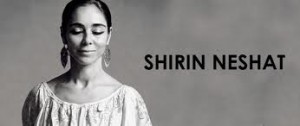 NEW YORK CITY — The work of Iranian-born artist Shirin Neshat, whose photographs, films and video installations deal with gender, politics and religion in the Islamic world, has been heralded by art critics and collected by major museums.
NEW YORK CITY — The work of Iranian-born artist Shirin Neshat, whose photographs, films and video installations deal with gender, politics and religion in the Islamic world, has been heralded by art critics and collected by major museums.
Although Neshat has lived in the United States since the 1970s, her work has most often been focused on the lives of women in Iran, and more recently with the aftermath of the Arab Spring in Egypt.
In 2010, a critic for The Huffington Post named her "Artist of the Decade," saying that Neshat's art reflects the struggle for human rights by "voiding stereotypes," revealing the "diversity within Islam and Iran."
Neshat's 2009 film, Women Without Men, a magical-realist tale of women in Iran at the time of the 1953 coup, won the top directing award at the Venice Film Festival.
She is equally well known for her photographic portraits, on which she inscribes verses of Persian poetry in tiny script. Her current show, Our House Is on Fire, is at New York's Robert Rauschenberg Foundation, which chose Neshat for its annual human rights commission to an individual artist. She used it to make portraits of poor, elderly people in Egypt. She conceived the project after the sudden death of the daughter of her long-time photographer, Larry Barns.
“The concept of this exhibition is about the aftermath of the wonderful Arab Spring, which we hope is still continuing, but for the moment has had some catastrophic results,” Neshat said in an interview. “And I wanted to create a group of photographs that talks about the human dimension, the street people that have lost a great deal, lost loved ones.”
She interviewed men and women through an Arabic language interpreter, asking them to think about the losses they had suffered as Barns captured their images.
“I told them if they wanted to talk about it, I was all ears, but if they didn't want to talk about it, and just respond to it by their facial expression, that was also perfectly fine. It's the first time I have come this close to being a documentary artist, in a way that's really tapping into real human beings and real emotions, as opposed to fictional characters that try to play a role,” she said.
The portraits resemble photo-realistic drawings, an effect caused by the microscopic calligraphy overlaid on the faces, visible only in extreme close-up.?The show also includes photographs of feet, soles up, with identifying toe-tags dangling. Neshat said those images were in response to the Egyptian military's attack on Muslim Brotherhood protesters last summer.
“I was just struck by the endless amount of images I saw of dead young people, that were all laid down, and they had these feet, and the tag that came as their identity, I suppose,” Neshat said. “And I felt in the context of this narrative that it was very important for us to remind ourselves again that the euphoric and wonderful, inspiring energy that came from the Arab Spring, so much of it ended in terrible violence.”
The Rauschenberg Foundation will donate the proceeds from two of the works from Our House Is on Fire to a rights initiative of the artist's choosing, in this case, human rights in Egypt. Neshat’s next project is a fictional film about the legendary Egyptian singer Umm Kulthum, which she plans to begin shooting later this year or early in 2015.
By VOA
The Iran Project is not responsible for the content of quoted articles.

 QR code
QR code